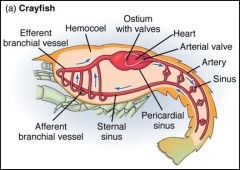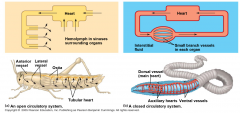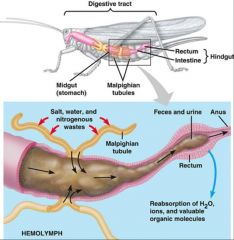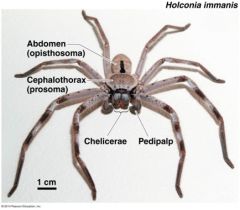![]()
![]()
![]()
Use LEFT and RIGHT arrow keys to navigate between flashcards;
Use UP and DOWN arrow keys to flip the card;
H to show hint;
A reads text to speech;
45 Cards in this Set
- Front
- Back
|
What is a Ecdysozoan ? |
Grow intermittently by molting - Shedding of soft cuticle or hard exoskeleton Once the animal molts, fluid causes the body to expand - the new, larger cuticle or exoskeleton forms Ecdysozoan's undergo a succession of molts as they grow - sometimes dramatic morphological transformations occur during molts |
|
|
Exoskeleton/Cuticle Advantages Exoskeleton Disadvantages |
Exoskeleton/Cuticle Advantages - protection from predators - provides effective structure for muscle attachment Exoskeleton Disadvanages - during molting, animals soft body is exposed and vulnerable - often cryptic during these times to avoid predators |
|
|
Arthropods are part of what Phylum
|
Arthropods are the most important phylum in Ecdysozoan Because: 1. duration in the fossil record: >520 MYA 2. species diversity: 1 Mill and more to be discovered 2. abundance of individuals: # of actual species |
|
|
Where are Arthropods found?
|
-found in nearly every environment - land, sea, marine, FW, -this is a reason why they are successful; they can adapt to all of these environments |
|
|
Arthropods are defined by three key features
|
1. Segmented Bodies: Organized into regions called Tagmata: -Head, thorax, and abdomen are common tagmata - or cephalothorax and abdomen 2. Chitinous (polysaccaride) exoskeleton - strengthened by calcium carbonate (CaCO3) in crustaceans 3. Jointed appendages: - enables them to move their rigid bodies - muscles apply force to move legs or wings at joints |
|
|
Describe Ancestral Arthropds
|
* ancestral arthropods showed little variation * Appendages were not specialized until later *early on they were very simple |
|
|
What can cause variations in Arthropod body plan?
|
* Variation in gene expression, combined with ecological opportunity through natural selection can result in diversification of arthropod body segments and appendages
|
|
|
What does coelom look like in an arthropod?
|
highly reduced
|
|
|
Hemocoel?
|
Part of an Arthropods successful body plan *spacious body cavity; less rigid *enables movement via a hydrostatic skeleton in some arthropod larvae (caterpillars) |
|
|
Jointed Appendages
|
Part of an Arthropods successful body plan * J.A's are organized in pairs along the segmented body They have an array of functions 1. Gas exchange (barnacles) 2. Sensing the environment 3. Feeding 4. Locomotion (swimming, walking, running, jumping, flying) |
|
|
What kind of circulatory system does and arthropod have and describe it
|
open circulatory system - blood bathes organs directly in an open circulatory system - no distinction between blood and interstitial fluid; this general body fluid is called hemolymph (can't tell what is blood or fluid) - humans have a closed circulatory system |
|
|
what is the Hemolymph?
|
the circulatory fluid of animals with open circulatory systems (e.g.) insects in which the fluid is not confined to blood vessels |
|

|

|
|
|
Gas Exchange in Arthropods
|
a variety of organs specialized for gas exchange have evolved in arthropods
|
|

Excretory Organs in Arthropds |
|
|
|
Malphigian Tubules? |
are a series of branching tubes that absorb waste and H20 from surrounding hemolymph Pooping |
|
|
Arthropod Metamorphosis 2 types |
|
|
|
Hemimetabolous
|
Incomplete Metamorphosis
|
|
|
Holometabolous
|
|
|
|
Pupa |
part of Holometabolous metamorphisis Stage when larvae stop feeding & moving & secrete a protective case
|
|
|
phylum arthropod - subphylum MYRIAPOD
|
- a head region - a long trunk with a series of segments (each segment bears one or two pairs of legs) - one pair of antennae on head - three pairs of appendages modified as mouth parts - can be venomous - very easy to recognize - can grow rapidly |
|
|
Myriapod's Sub Classes (two)
|
Diplopoda (millipedes) - 2 pairs of legs per segment, herbivorous/ detritovores - rolling as a defense mechanism - some with >190 trunk segments Chilopods (centipedes) - 1 pair of legs per segment, carnivorous - toxic substances kill prey - usually fewer than 30 segments |
|
|
Myriapoda reproduction |
-sexes are separate -Internal fertilization (females lay eggs that hatch into juveniles that develop into adults via a series of molts) |
|
|
Phylum Arthropoda - Class Insecta |
- 1 million species of insects have been named (.1mm-20cm) more are certain to exsist - dominate terrestrial enviro's in terms of species abundance AND diversity - Drosophila Melanogaster is one of the most thoroughly studies model organism in biology! (e.g. fruit fly) -incomplete and complete metamorphosis - constrained in how big they get because of heavy exoskeleton |
|
|
Class Insects - Tagmata
|
3 distinguishing Tagmata: 1.Head which contains: - a pair of antennae used for touch and smell - a pair of compound eyes (pixilated vision) - 4 sets of mouthparts 2.Thorax which contains: - three pairs f walking legs on the lateral surface - one or two pairs of wings attached to the dorsal surface - insects use legs to walk, run, jump, swim, fly 3.Abdomen |
|
|
due to natural selection, describe insect feeding
|
- N.S has resulted in extreme diversity in form and function of mouthparts - As a result, insects feed in EVERY way and on almost every type of food source available on land |
|
|
Phylum Arthropod- Class Insecta Reproduction |
1. insect sexes are usually separate & repro is usually sexual - mating usually direct copulation, in which male inserts a sperm-transfer organ into the female 2. many species are capable of asexual repro through Parthenogenesis (no male needed, bees, ants, wasps) 3. most undergo either complete or, less common incomplete metamorphsis |
|
|
Phylum Arthropod - Subphylum Crustacae
|
- 47,000 species - primarily FW or marine - crustaceans, esp copepods, are important consumers in the surface waters around the world -Crustaceans are also important grazers and predators in shallow water benthic enviro's - large source of our food - can be bigger-do not rely on muscles to support their body's - eat algae (important for the rest of the food chain) |
|
|
Phylum Arthropods - Subphylum Chelicerata |
-100,000 species (.1-28 cm) - most terrestrial, some marine - Sea-spiders (marine), horseshoe crabs (marine), daddy longlegs, mites, ticks, spiders, scorpions - The most prominent chelicerate lineage is the Arachnida - spiders, scorpions, ticks, mites, daddy longlegs |
|
|
Subphylum Crustacae Body |
they have: - two pairs of antennae (only arthropods with this) - sophisticated, compound eyes that are usually mounted on stalks (efficient at knowing the enviro and can see from multi angeles) - branched appendages - segmented body divided into two tagmata 1. Cephalothorax, which contains head and thorax 2. Abdomen - Many crustaceans have a Carapace; a plate-like section of the exoskeleton that covers and protects the cephalothorax |
|
|
Subphylum Crustacae Eating |
- most crustaceans have 4-6 pairs of mouthparts - as a group, they use every type of feeding strategy known: species are hunter, scavengers, or herbivores - have mouthparts called Mandibles that bite or chew -often use their claws to grasp their prey |
|
|
Carapace |
a plate-like section of the exoskeleton that covers and protects the cephalothrax (e.g. crustaceans) |
|
|
Mandibles |
any mouthpart used in chewing invertebrates, the lower jaw. In insects, crustaceans and myriapods, the 1st pair of mouthparts |
|
|
Phylum Arthropods - Subphylum Crustacea Limbs |
- have many paired limbs (10 to 12 sometimes) - limb structure is highly variable (claws, paddle-shaped forms used for swimming, feathery structures used for capturing food suspended in H2O, slender legs used for running) - Very few are sessile *adult (not larvae) barnacles cement their heads to a hard surface |
|
|
Phylum Arthropods - Subphylum Crustacea Reproduction |
- In most crustaceans: - repro is sexual with internal fertilization and eggs are retained by female until they hatch - Most species pass through several larval stages *many species include a planktonic larvae stage called a Nauplius |
|
|
Nauplius |
planktonic larvae stage with several larvae stages |
|
|
Phylum Arthropods - Subphylum Chelicerata Body |
- Consists of two tagmata 1. the cephalothorax - the cephalothorax lacks antennae but usually contains eyes - 6 pairs of appendages 2. The abdomen |
|
|
Phylum Arthropods - Subphylum Chelicerata Feeding |
Chelicerates have a variety of feeding behaviors - spiders, daddy longlegs, scorpions are predators - mites, ticks are ectoparasites - horseshoe crabs eat animals, algae, detrirus Most spiders secrete digestive enzymes into prey - digestion begins externally, and spider later drinks liquid |
|
|
Phylum Arthropods - Subphylum Chelicerata Movement |
move by using muscles attached to their exoskeleton - some species are capable of jumping and others swimming - newly hatched spiders spin long, silken threads that serve as balloons and carry them hundreds of kilometers (most spiders lack parents) |
|
|
Phylum Arthropods - Subphylum Chelicerata Reproduction |
Most: - repro is sexual with internal fertilization -courtship displays are extensive (including visual displays and chemical odorants) - in spiders, males use pedipalds to transfer sperm to females Development is Direct: - there are no larval forms - metamorphosis does not occur |
|
|
Pedipalds |
a pair of appendages found next to the claw-like chelicerae of certain arthropods called chelicerates (spiders, mites, and relatives); used to manipulate food, transfer sperm, or other functions |
|
|
What two Ecdyozoan's are model organisms? |
Caenorhabditis Elegans -Roundworm Drosophila melanogaster - Insecta (fruit flies) |
|
|
Appendages of Phylum Arthropods - Subphylum Chelicerata |
Appendages include 4 pairs of legs 1 pair of chelicerae, which are found near the mouth Used for feeding, defense, copulation, movement, or sensory reception 1 pair of pedipalps:Contain sensitive chemical detectors and function as taste and smell organs |
|
|
Chelicerae |
a pair of clawlike appendages found near the mouth of chelicerates
|
|

|
|

